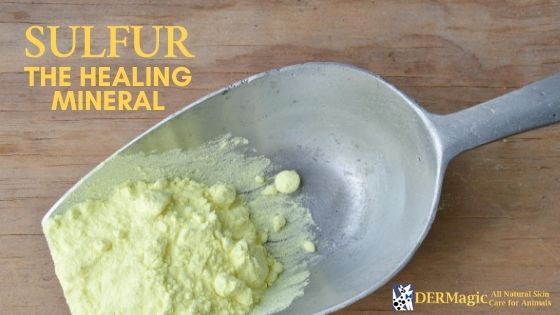
We often get questions from our customers about the ingredients in our products.
Today we're going to talk about one of the most common confusions that surround sulfur-containing compounds.
Some are beneficial, some are vital to the proper functioning of cells, some are caustic and toxic and contribute to acid rain, some are antibiotic medicines.
Today's blog is just a brief introduction to the vast array of compounds that contain sulfur, so if you still have questions after reading this, please write to us!
What is the difference between Sulfur and Sulfates?
Many treatments for our pet’s skin problems often include harsh chemicals (like sulfates) and steroids, which can make skin conditions worse!
DERMagic Skin Care for Animals was created as an alternative to such traditional solutions to alleviate itching and scratching – only using natural and certified organic ingredients.
Sulfur and sulfates are related compounds, but are as different as the free nitrogen in the air we breathe is different from the nitrates in nitric acid.
Sulfur is Toxic to the Scabies Mites
Sulfur, known as the healing mineral, is toxic to the scabies mite, and is both an antibacterial and potent antifungal, making it a natural "disinfectant".
You'll find sulfur in DERMagic’s Skin Rescue Lotion. Our lotion provides proven relief from itchy skin and is the only topical product on the market that can reverse a systemic yeast infection, with no harmful side effects.
Sulfur is an essential element for all life, and is widely used in biochemical processes. Elemental sulfur is non-toxic to animals, including humans, and can be taken internally as a mild laxative.
In metabolic reactions, sulfur compounds serve as both fuels and respiratory (oxygen-replacing) materials for simple organisms.
Sulfur in organic form is present in the vitamins biotin and thiamine, the latter being named for the Greek word for sulfur.
Sulfur is an important part of many enzymes and in antioxidant molecules like glutathione and thioredoxin. Organically bonded sulfur is a component of all proteins, as the amino acids, cysteine and methionine.
Disulfide bonds are largely responsible for the mechanical strength and insolubility of the protein keratin, found in outer skin, hair, and feathers, and the element contributes to their pungent odor when burned.
Sulfates, on the other hand, are a type of compound made when elemental sulfur burns in air. The principal sulfur oxides (or sulfates) are obtained by burning sulfur:
S + O2 → SO2 (Sulfur + Oxygen = Sulfur dioxide)
2 SO2 + O2 → 2 SO3 (Sulfur dioxide + more oxygen = Sulfur trioxide.)
When these compounds encounter water (in the air, in the lungs), they form sulfurous or sulfuric acid, highly caustic compounds. Sulfates occur as microscopic particles (aerosols) resulting from fossil fuel and biomass combustion. They increase the acidity of the atmosphere and form acid rain.
When cosmeceutical manufacturers claim their products have no sulfates, they are usually referring to something completely different, i.e., Sodium Laurel Sulfate (and closely related sodium laureth sulfate) or SLS.
SLS is mainly used in detergents for laundry with many cleaning applications. SLS is a highly effective surfactant (surface active agent) and is used in any task requiring the removal of oily stains and residues.
For example, it is found in higher concentrations with industrial products including engine degreasers, floor cleaners, and car wash soaps.
SLS is found in toothpastes, shampoos, shaving foams, and bubble bath formulations in part for its thickening effect and its ability to create a lather. It has been shown to irritate the skin of the face with prolonged and constant exposure (more than an hour) in young adults. SLS may worsen skin problems in individuals with chronic skin hypersensitivity, with some people being affected more than others. In animal studies SLS appears to cause skin and eye irritation.
Most shampoos for pets contain SLS. DERMagic products do not.
But, what about Sulfa?
This is another common area of confusion. “Sulfa drugs” (known as sulfonamides) are a type of antibacterial medication that contains the “sulfonamide” group (sulfur, oxygen and nitrogen).
Sulfa allergies in people are common, and medications containing sulfonamides are prescribed carefully.
It is important to make a distinction between sulfa drugs and other sulfur-containing drugs and additives, such as sulfates and sulfites, which are chemically unrelated to the sulfonamide group.
Please contact us if you ever have any questions about any of the ingredients in our products. We love to talk about this! Meanwhile, here's wishing you and yours the best of good health!

